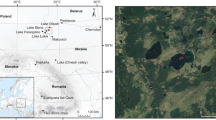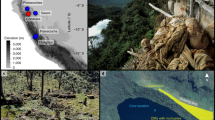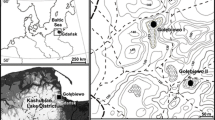Abstract
Appropriate management of contemporary environments requires knowledge of their long-term history. We use palaeoecological data to explore how contemporary forest-steppe environments have been shaped by climate change and human impacts through the Holocene using the western Mid-Russian Upland as a case-study. Our paper presents new reconstructions of Mid- and Late Holocene climate, vegetation dynamics and local environmental change based on pollen, plant macrofossil and testate amoeba records from a site at Selikhovo (Mid-Russian Upland, Russia). Eutrophic fen vegetation dominated by Phragmites australis developed around 6800 cal year BP and has been resilient to episodes of local burning and variable input of mineral material through the Holocene. New and previously-published data show that the boundary between broadleaf forest and steppe occupied a similar position to present during the period 7000–4800 cal year BP, despite a warmer and drier climate, but shifted to the south following climate cooling and an increase in precipitation from 4800–2500 cal year BP. A subsequent decline in woodland cover was caused by both climate change and human impacts, with human activity becoming increasingly significant over the last two millennia. Prior to major human disturbance (about 1700 cal year BP) the landscape was dominated by mixed broadleaf-pine forests with some spruce covering about 60 % of the study area. Our results emphasize the variability of steppe-forest habitats over long time periods and the need to consider human impacts and climate change when setting targets for habitat conservation.







Similar content being viewed by others
References
Aleksandrovskiy AL, Chichagova OA (1998) Radiocarbon age of Holocene paleosols of the East European forest–steppe zone. Catena 34:197–207
Bartalev SA, Egorov BA, Ershov DV, Isaev AS, Lupyan EA, Plotnikov DE, Uvarov IA (2011) Satellite mapping of the vegetation cover of Russia by data of the spectroradiometer MODIS. Modern problems of remote sensing of the earth from space 8:285–302 (in Russian)
Behre K-E (1988) The role of man in European vegetation history. In: Huntley B, Webb T III (eds) Vegetation history. Kluwer, Dordrecht, pp 633–672
Bennett KD (1996) Determination of the number of zones in a biostratigraphical sequence. New Phytol 132:155–170
Blagoveshenskaya NV (2009) Vegetation history of the central part of the Privolzhskaya Upland in the Holocene. Dissertation, Ul’yanovsk State University (in Russian)
Borisova O, Sidorchuk A, Panin A (2006) Palaeohydrology of the Seim River basin, Mid-Russian Upland, based on palaeochannel morphology and palynological data. Catena 66:53–73
Bradley RS (2008) Holocene perspectives on future climate change. In: Battarbee RW, Binney HA (eds) Natural climate variability and global warming: a Holocene perspective. Wiley & Sons, Blackwell, pp 254–268
Core Team R (2012) R: A language and environment for statistical computing. R Foundation for Statistical Computing, Austria
Davis BAS, Brewer S, Stevenson ACA, Guiot J, Contributors Data (2003) The temperature of Europe during the Holocene reconstructed from pollen data. Quat Sci Rev 22:1701–1716
Dean W Jr (1974) Determination of carbonate and organic matter in calcareous sediments and sedimentary rocks by loss on ignition: comparison with other methods. J Sediment Res 44:242–248
Dombrovskaya AV, Koreneva MM, Turemnov SN (1959) Atlas of plant remains in peat. Nauka, Moscow (in Russian)
Ershov DV (2007) Methods of assessment of area covered by forests using satellite imaging MODIS of moderate spatial resolution. Curr Probl Rem Sens Earth Space 2:217–225 (in Russian)
Feurdean A, Klotz S, Mosbrugger V, Wohlfarth B (2008) Pollen-based quantitative reconstructions of Holocene climate variability in NW Romania. Palaeogeogr Palaeoclimatol Palaeoecol 260:494–504
Feurdean A, Marinova E, Nielsen AB, Liakka J, Veres D, Hutchinson SM, Mihaly Braun M, Timar-Gabor A, Astalos C, Mosburgger V, Hickler T (2015) Origin of the forest steppe and exceptional grassland diversity in Transylvania (central-eastern Europe). J Biogeogr 42:951–963
Folomeev BA, Aleksandrovsky AL, Glasko MP, Gonyanyi MI, Guman MA (1990) Ancient settlements and environment in mouth part of Nepryavda river. In: Zaitzev AK (ed) Kulikovo Battle Field: materials of investigation. State Historical Museum-Press, Moscow, pp 10–53
Gonianyi MI, Aleksandrovskiy AL, Glasko MP (2007) Northern forest-steppe of the Upper Don River basin at the time of the Kulikovo Battle. State Historical Museum-Press, Moscow (in Russian)
Gribova SA, Isachenko TI, Lavrenko EM (1980) Vegetation of the European part of the USSR. Nauka, Leningrad (in Russian)
Grichuk VP (1940) Method of treatment of the sediments poor in organic remains for the pollen analysis. Problems Fiz Geogr 8:53–58 (in Russian)
Grimm ECA (1987) CONISS: a FORTRAN 77 program for stratigraphically constrained cluster analysis by the method of incremental sum of squares. Comput Geosci 13:13–35
Grimm ECA (1990) TILIA and TILIA*GRAPH.PC spreadsheet and graphics software for pollen data. INQUA Working Group Data-Handling Methods Newsl 4:5–7
Guiot J (1990) Methodology of the last climatic cycle reconstruction in France from pollen data. Palaeogeogr Palaeoclimatol Palaeoecol 80:49–69
Hansen M, DeFries RS, Townshend JRG, Carroll M, Dimiceli C, Sohlberg RA (2003) Global percent tree cover at a spatial resolution of 500 meters: first results of the MODIS vegetation continuous fields algorithm. Earth Interact 7:1–15
Kaplan JO, Krumhardt KM, Zimmermann N (2009) The prehistoric and preindustrial deforestation of Europe. Quat Sci Rev 28:3016–3034
Katz NY, Katz SV, Skobeva EI (1977) Atlas of plant remains in peat. Nedra-press, Moscow (in Russian)
Khotinsky NA (1977) Holocene of Northern Eurasia. Nauka, Moscow (in Russian)
Khotinsky NA (1993) Anthropogenic changes in the landscapes of the Russian Plain during the Holocene. Grana 32(Suppl 2):70–74
Klimanov VA, Serebryannaya TA (1986) The change of vegetation and climate of the Mid-Russian Upland in the Holocene. USSR Acad Sci Izv Ser Geogr 2:93–101 (in Russian)
Klimanov VA, Sirin AA (1997) Dynamics of peat accumulation in beatbogs of the Northern Eurasia during the last 3000 years. Dokl Akad Nauk 354:683–686 (in Russian)
Korhola A, Ruppel M, Seppä H, Väliranta M, Virtanen T, Weckström J (2010) The importance of northern peatland expansion to the late-Holocene rise of atmospheric methane. Quat Sci Rev 29:611–617
Krasnoschekova SD, Krasnitskiy LN (2006) Archeology of Orel region. Veshnie vody Press, Orel (in Russian)
Krasnov YA (ed) (1999) Archeological map of Russia. Orel region, part 1. Institute of archeology RAS Press, Moscow (in Russian)
Krupenina LA (1974) The age and conditions of sedimentation of floodplain deposits of the Rivers Seim and Krom. USSR Acad Sci Izv Ser Geogr 2:82–89 (in Russian)
Lamentowicz M, Cedro A, Gałka M, Miotk-Szpiganowicz G, Mitchell EAD, Pawlyta J, Goslar T (2008) Last millennium palaeoenvironmental changes from a Baltic bog (Poland) inferred from stable isotopes, pollen, plant macrofossils and testate amoeba. Palaeogeogr Palaeoclimatol Palaeoecol 265:93–106
Lavrushin YA, Spiridonova EA, Bessudnov AN, Smol’yaninov PB (2009) Holocene natural catastrophes in the Upper Don river basin. GEOS, Moscow (in Russian)
Lazarova M, Bozilova E (2001) Studies on the holocene history of vegetation in the region of the lake Srebarna (northeast Bulgaria). Veg Hist Archaeobot 10:87–95
Leonenko M (1971) Geology of the USSR. The center of the European part of the USSR, vol 5. Nedra-Press, Moscow
Lishtvan II, Korol NT (1975) The main properties of peat and methods of its determination. Nauka i Technika, Minsk (in Russian)
MacDonald GM, Beilman DW, Kremenetski KV, Sheng Y, Smith LC, Velichko AA (2006) Rapid early development of circumarctic peatlands and atmospheric CH4 and CO2 variations. Science 314:285–288
Magyari EK, Chapman JC, Passmore DG, Allen JRM, Huntley JP, Huntley B (2010) Holocene persistence of wooded steppe in the Northern Great Hungarian Plain. J Biogeogr 37:915–935
Mann ME, Zhang Z, Rutherford S et al (2009) Global signatures and dynamical origins of the little ice age and medieval climate anomaly. Science 326:1256–1260
Mayewski PA, Rohling BE, Stager G (2004) Holocene climate variability. Quat Res 62:243–255
Mazei YA, Embulaeva EA (2009) Changes in the communities of soil-dwelling testate amoebae along the forest-steppe gradient in the Middle Volga Region. Arid Ecosyst 37:13–27
Moskal-del Hoyo M (2013) Mid-holocene forests from Eastern Hungary: new anthracological data. Rev Palaeobot Palynol 193:70–81
Nakagawa T, Tarasov P, Kotoba N, Gotanda K, Yasuda Y (2002) Quantitative pollen-based climate reconstruction in Japan: application to surface and late Quaternary spectra. Quat Sci Rev 21:2099–2113
Novenko EY, Glasko MP, Burova OV (2009) Landscape-and-climate dynamics and land use in late holocene forest-steppe ecotone of East European Plain (upper Don River Basin case study). Quat Int 203:113–119
Novenko EY, Volkova EM, Glasko MP, Zuganova IS (2012) Palaeoecological evidence for the middle and late Holocene vegetation, climate and land use in the upper Don River basin (Russia). Veget Hist Archaeobot 21:337–352
Novenko EYu, Eremeeva AP, Chepurnaya AA (2014a) Reconstruction of Holocene vegetation, tree cover dynamics and human disturbances in central European Russia, using pollen and satellite data sets. Veg Hist Archaeobot 23(Suppl 1):109–119
Novenko EY, Rudenko OV, Volkova EM, Zuganova IS (2014b) Vegetation dynamics in the national park “Orlovskoye Polesye” in the late Holocene. Sci Notes Orel State Univ 3:302–310 (in Russian)
Novenko EY, Tsyganov AN, Volkova EM, Babeshko KV, Lavrentiev NV, Payne RJ, Mazei YA (2015) The Holocene paleoenvironmental history of central European Russia reconstructed from pollen, plant macrofossil, and testate amoeba analyses of the Klukva peatland, Tula region. Quat Res 83:459–468
Olsson F, Gaillard MJ, Lemdahl G, Greisman A, Lanos P, Marguerie D, Marcoux N, Skoglund P, Wäglind J (2010) A continuous record of fire covering the last 10,500 calendar years from southern Sweden—the role of climate and human activities. Palaeogeogr Palaeoclimatol Palaeoecol 291:128–141
Overpeck JT, Webb T III, Prentic ICA (1985) Quantitative interpretation of fossil pollen spectra: dissimilarity coefficients and the method of modern analogs. Quat Res 23:87–108
Parnell AC, Haslett J, Allen JRM, Buck CE, Huntley B (2008) A flexible approach to assessing synchroneity of past events using Bayesian reconstructions of sedimentation history. Quat Sci Rev 27:1872–1885
Payne R (2009) The standard preparation method for testate amoebae leads to selective loss of the smallest shells. Quat Newsl 119:16–20
Power MJ, Marlon J, Ortiz N et al (2008) Changes in fire regimes since the last glacial maximum: an assessment based on a global synthesis and analysis of charcoal data. Clim Dyn 30:887–907
Reimer PJ, Bard E, Bayliss A, Beck JW, Blackwell PG, Bronk Ramsey C, Buck CE, Cheng H, Edwards RL, Friedrich M, Grootes PM, Guilderson TP, Haflidason H, Hajdas I, Hatté C, Heaton TJ, Hoffmann DL, Hogg AG, Hughen KA, Kaiser KF, Kromer B, Manning SW, Niu M, Reimer RW, Richards DA, Scott EM, Southon JR, Staff RA, Turney CSM, van der Plicht J (2013) IntCal13 and Marine13 radiocarbon age calibration curves, 0–50,000 years cal BP. Radiocarbon 55:1869–1887
Serebryannaya TA (1976) Interrelations between forest and steppe on Central Russian Upland in Holocene. In: Dinesman LG (ed) The history of biocenoses of USSR in Holocene. Nauka, Moscow, pp 159–166 (in Russian)
Serebryannaya TA (1981) The human impact on vegetation of Central Russian Upland (by palynological data). In: Voropaev GV (ed) Anthropogenic factors in the history of the development of modern ecosystems. Nauka, Moscow, pp 52–60 (in Russian)
Sidorchuk A, Panin A, Borisova O (2012) River runoff decrease in North-Eurasian plains during the Holocene optimum. Water Resour 39:69–81
Simpson GL, Oksanen J (2012) Analogue: analogue matching and modern analogue technique transfer function models. (R package version 0.8-2). http://cran.r-project.org/package=analogue
Spiridonova EA (1991) Evolution of vegetation cover of Don Basin in upper Pleistocene and Holocene. Nauka, Moscow (in Russian)
Sümegi P, Persaits G, Gulyás S (2012) Woodland-grassland ecotonal shifts in environmental mosaics: lessons learnt from the environmental history of the Carpathian Basin (Central Europe) during the holocene and the last ice age based on investigation of paleobotanical and mollusc remains. In: Myster RW (ed) Ecotones between forest and grassland. Springer, New York, pp 17–57
Sycheva S, Glasko M, Chichagova O (2003) Holocene rhythms of soil formation and sedimentation in the Central Russian Upland. Quat Int 106–107:203–213
Ter Braak CA (1995) Ordination. In: Jongman R, ter Braak C, van Tongeren O (eds) Data analysis in community and landscape ecology. Pudoc, Wageningen, pp 91–173
Troels-Smith J (1955) Karakterisering af lose jordater (characterisation of unconsolidated sediments). Dan Geol Undersogelse 3:39–73 (in Danish)
Turner C (1996) The early middle pleistocene in Europe. Balkema, Rotterdam
Velichko AA, Faustova MA, Pisareva VV, Gribchenko YN, Sudakova NG, Lavrentiev NV (2011) Glaciations of the East European Plain: distribution and chronology. In: Ehlers J, Gibbard PL, Hughes PD (eds) Quaternary glaciations—extent and chronology. Elsevier, Amsterdam, pp 337–359
Volkova EM (2011) Rare mires of the north-western Mid Russia Upland: vegetation and genesis. Bot J 96:55–70 (in Russian)
Vomperski SE, Tzyganova OP, Kovalev AG et al (1999) Paludified lands in Russia as a factor of carbon accumulation. In: Zavarzin GA (ed) Global evolution of biosphere. Russian Academy of Science, Moscow, pp 124–145 (in Russian)
Wanner H, Beer J, Bütikofer J, Crowley TJ, Cubasch U, Flückiger J, Goosse H, Grosjean M, Joos F, Kaplan JO, Küttel M, Müller SA, Prentice IC, Solomina O, Stocker TF, Tarasov PE, Wagner M, Widmann M (2008) Mid- to late holocene climate change: an overview. Quat Sci Rev 27:1791–1828
Williams JW, Shuman B (2008) Obtaining accurate and precise environmental reconstructions from the modern analog technique and North American surface pollen dataset. Quat Sci Rev 27:669–687
Acknowledgments
This work was supported by the Russian Foundation for Basic Research, Projects 14-05-00550. Microscopic analysis of testate amoeba data was supported by the Grant of the President of Russian Federation (MD-4435.2014.4). The palaecological analysis of testate amoeba data provided by A. Tsyganov and Y. Mazei was supported by Russian Science Foundation (Project 14-14-00891). Analysis of experimental data in respect of project future climate changes was provided by A. Olchev within the framework of the grant of the Russian Science Foundation (14-14-00956).
Author information
Authors and Affiliations
Corresponding author
Additional information
Communicated by Jürgen Dengler.
Rights and permissions
About this article
Cite this article
Novenko, E.Y., Tsyganov, A.N., Rudenko, O.V. et al. Mid- and late-Holocene vegetation history, climate and human impact in the forest-steppe ecotone of European Russia: new data and a regional synthesis. Biodivers Conserv 25, 2453–2472 (2016). https://doi.org/10.1007/s10531-016-1051-8
Received:
Revised:
Accepted:
Published:
Issue Date:
DOI: https://doi.org/10.1007/s10531-016-1051-8




